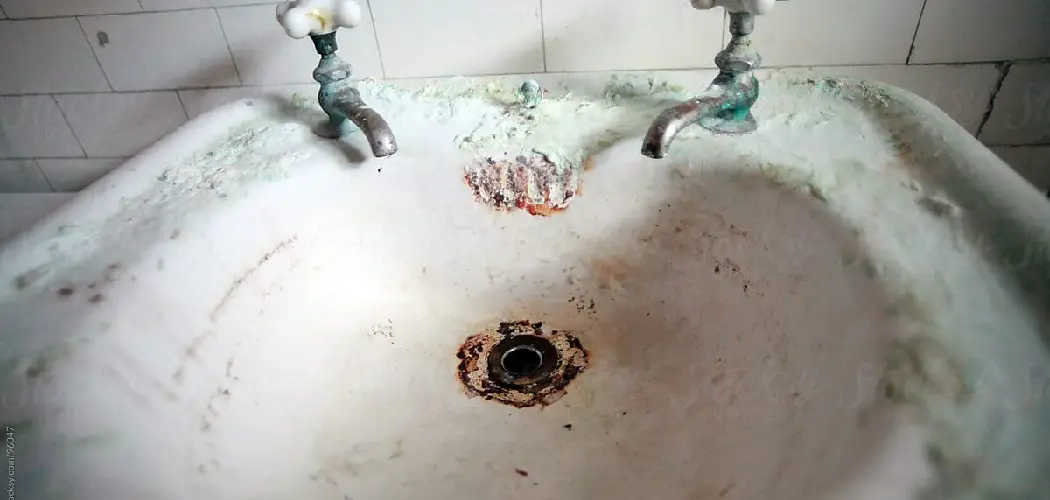Are you having trouble with calcium buildup in your shower drain? Are you ready for a reliable solution that will get rid of the problem once and for all? Don’t worry. We’ve got you covered!
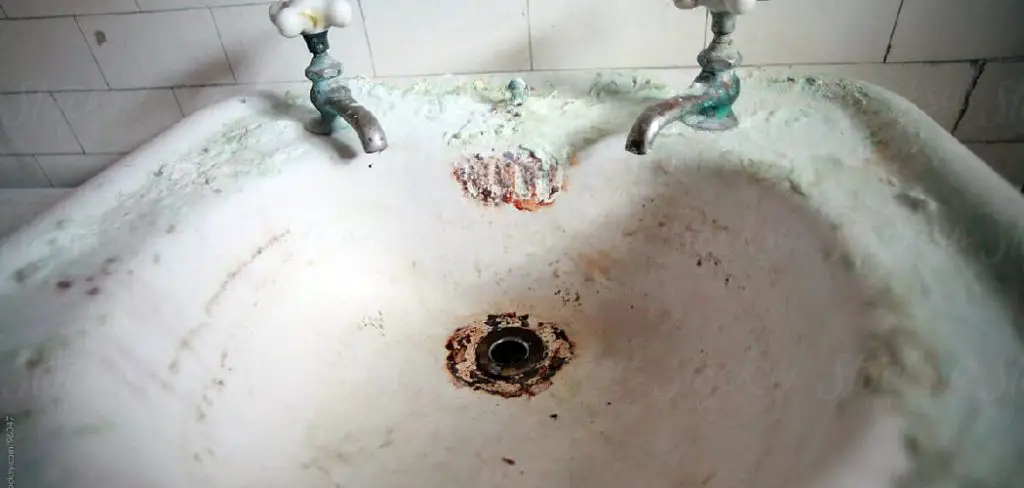
Shower drain clogs caused by calcium buildup can be a nuisance and lead to larger plumbing issues if not taken care of properly. In this guide, we will walk you through the steps on how to remove calcium buildup in shower drain.
Here, we’ll discuss the various ways to remove calcium buildup in your shower drain. From natural solutions to store-bought products, we’ll break down each method so that by the end, you can get rid of unsightly calcium deposits and have a free-flowing shower again. So, let’s start off by taking a closer look at why it happens and how to identify it.
What Will You Need?
Depending on the method you choose, here are some essential items you will need to remove calcium buildup in your shower drain:
- Baking soda
- White vinegar
- Lemon juice
- Boiling water
- A plunger or a plumbing snake (also known as an auger)
- Protective gloves and goggles for safety
Once you have gathered these items, let’s get down to business.
Why Does It Happen?
To understand how to remove calcium buildup in shower drain, it’s essential to know why it happens in the first place. Water that contains high levels of minerals like calcium and magnesium is known as “hard water.” When hard water evaporates, it leaves behind a residue of calcium and magnesium, which leads to the formation of calcium deposits.
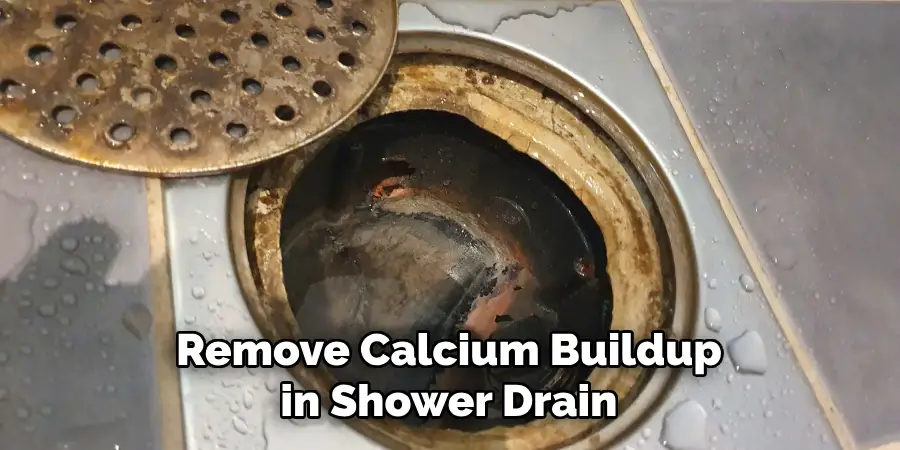
Over time, these deposits can build up in your shower drain, causing clogs and reducing water flow. The longer you ignore this issue, the more severe it can become. Now that we know what causes it let’s learn how to identify it.
10 Easy Steps on How to Remove Calcium Buildup in Shower Drain
Step 1: Safety First
Before you begin the cleaning process, remember to put on your protective gloves and goggles. This is a necessary step to ensure your safety, especially if you are dealing with stubborn calcium deposits that might require the use of solid and store-bought products. Always prioritize your safety when dealing with home repair or cleaning tasks.
Step 2: Prepare the Solution
In a suitable container, mix equal parts of white vinegar and baking soda. These natural cleaning agents work well together to dissolve calcium deposits. The vinegar’s acidity reacts with the alkaline baking soda to produce a fizzing action to help break down the buildup. Let the mixture sit for a few minutes before proceeding to the next step. If you’re dealing with a severe buildup, let it sit for about 15 minutes for maximum effectiveness.
Step 3: Apply the Solution
Carefully pour the baking soda and vinegar solution down the drain. Pour slowly so the mixture has time to work on the calcium buildup in your drain. Once you have run all the solution down the drain, wait for about 30 minutes to an hour for the solution to effectively dissolve the calcium deposits. The longer you wait, the more time the solution has to work on the buildup. While waiting, refrain from using the shower to ensure the solution works effectively.
Step 4: Rinse with Boiling Water
After waiting for the solution to do its job, it’s time to rinse it. Boil a pot of water and carefully pour it down the shower drain. The hot water will help to wash away the dissolved calcium deposits and the remaining solution.
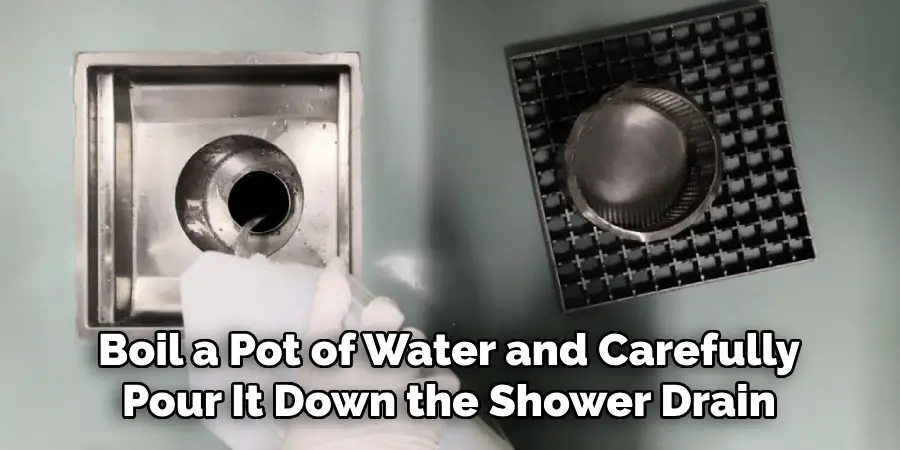
The water must be boiling hot (as long as it’s safe to do so) because hot water is more effective at removing the loosened buildup. Be sure to pour slowly and carefully to avoid any potential burns. Repeat this step if necessary until the solution and loosened deposits are entirely flushed out.
Step 5: Check the Drain
Once you have rinsed the drain, it’s time to check the status of the calcium buildup. If the water is draining properly, it means the calcium deposits have been successfully removed. However, if the drain is still slow, there could be some residual calcium buildup.
In this case, you may need to repeat steps 2 to 4 until the drain is apparent. For stubborn deposits, you may also consider using a plunger or a store-bought drain cleaner designed to remove calcium deposits. Always follow the product instructions to ensure safe and effective use.
Step 6: Use a Plunger or a Plumbing Snake
If the calcium buildup remains stubborn after trying the natural cleaning solution, it’s time to use a plunger or a plumbing snake. Wearing protective gloves, place the plunger over the drain and pump it several times to create suction.
The suction can help to dislodge the calcium buildup. If the plunger doesn’t work, you may use a plumbing snake. Insert the snake into the drain and turn it to break up the buildup. After this, rinse with boiling water again to remove the remaining deposits.
Step 7: Regular Maintenance and Prevention
After successfully removing the calcium buildup, it’s crucial to maintain your shower drain regularly to prevent future buildup. Periodically rinsing the drain with a mixture of vinegar and baking soda can help prevent calcium deposits.
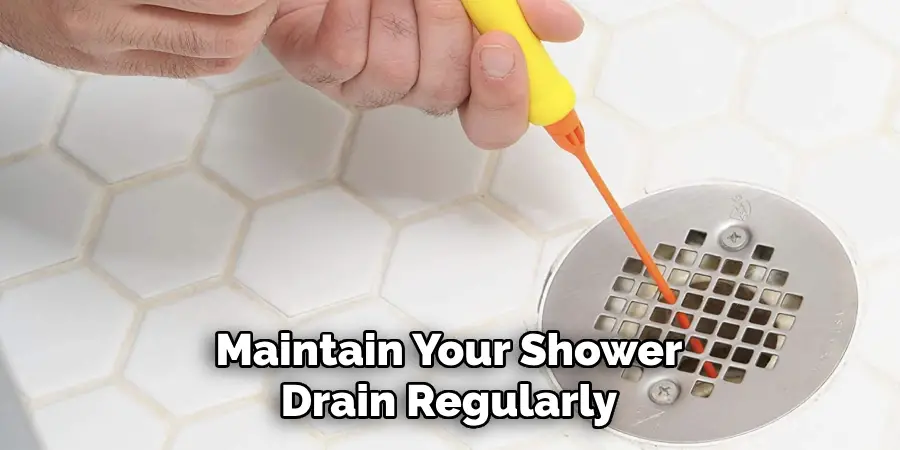
Consider installing a water softener if hard water is common in your area, as this can significantly reduce the amount of calcium and magnesium in the water. Regular maintenance and preventative measures can save you from dealing with stubborn calcium buildup in the future.
Step 8: Final Inspection
After you’ve finished the cleaning process and taken preventative measures, inspect your shower drain to ensure no calcium buildup remains. You should use a flashlight to check the inner sections of the drain. You may need to repeat the cleaning process or consider professional help if you notice any leftover deposits.
Remember, persistent buildup might indicate a more severe plumbing issue that requires an expert’s attention. Regular inspections are essential to keep your shower drain clean and functioning optimally.
Step 9: Seek Professional Help if Needed
Despite your best efforts, if the calcium buildup persists and your drainage remains slow, it may be time to call in a professional plumber. A plumber has specialized tools and expertise to handle stubborn calcium buildup and other potential issues, which might be out of scope for a DIY approach.
They can thoroughly inspect your plumbing system, identify the root of the problem, and provide effective solutions. Remember, trying to force a solution could lead to costly damage, so don’t hesitate to seek professional help when necessary.
Step 10: Regular Inspections
Even after the calcium buildup has been effectively dealt with, it’s essential to inspect your shower drain regularly. This step is crucial in identifying any signs of calcium buildup before it becomes a significant issue. Regular inspections, coupled with preventative maintenance, will help in avoiding future blockages, ensuring the smooth functioning of your drainage system.
If you notice any signs of calcium deposits during these inspections, repeat the cleaning process promptly. Remember, consistent maintenance is always more accessible and cost-effective than dealing with a severe blockage.
Following these steps and taking preventative measures can effectively remove calcium buildup from your shower drain.
5 Additional Tips and Tricks
- Regular Cleaning: To ensure that the calcium buildup does not become too severe, make it a habit to clean your shower drain regularly. This preventive measure can save you from significant hassles down the line.
- Vinegar and Baking Soda: This dynamic duo can be quite effective for minor calcium buildup. Pour a cup of baking soda down the drain, followed by a cup of vinegar. Wait for 15 minutes and then rinse with hot water.
- Commercial Cleaners: For more challenging deposits, you might need to resort to specialized commercial cleaners. Ensure you choose a product designed explicitly for calcium buildup and follow the manufacturer’s instructions.
- Professional Help: If the calcium buildup is extensive or the drain is not easily accessible, do not hesitate to call in a professional. They have the tools and expertise to handle complicated situations.
- Preventive Measures: Finally, consider installing a water softener to prevent calcium buildup in the first place. This can be particularly beneficial if you live in an area with hard water.
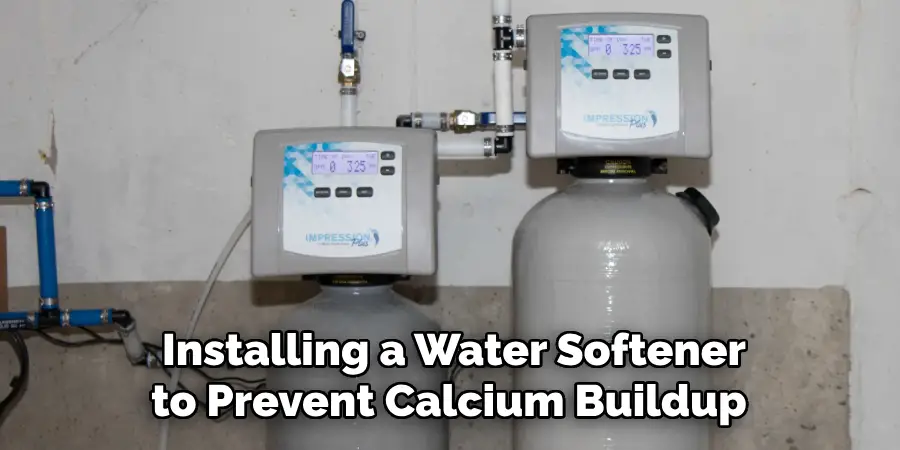
With these additional tips and tricks, you can keep your shower drain clean and free from calcium buildup.
5 Things You Should Avoid
- Ignoring the Issue: Calcium buildup can lead to severe problems if left unchecked. Ignoring the issue will only worsen, leading to potential blockages and costly repairs.
- Harsh Chemicals: While it might be tempting to use aggressive cleaning products, these can damage your pipes and harm the environment. Always opt for non-abrasive, eco-friendly alternatives where possible.
- Forcing the Drain: Never force open a clogged drain, as it may cause damage to the pipes and lead to a bigger problem.
- Neglecting Regular Maintenance: Regular cleaning and maintenance is the key to preventing calcium buildup. Ignoring these tasks will make it easier for the buildup to occur and harder for you to remove.
- Skipping Safety Measures: If using commercial cleaners, always follow safety precautions. Avoid direct skin contact and ensure the area is well-ventilated to avoid inhaling toxic fumes.
Avoiding these common mistakes can effectively remove and prevent calcium buildup in your shower drain.
Conclusion
To sum it up, calcium buildup in shower drains can undoubtedly be a nuisance. From using vinegar and baking soda to specialized store-bought cleaners or calling in an expert to do the job, there are plenty of ways to address this pesky problem. The most important thing is to take action immediately, as a build-up of hardened calcium can cause clogging and damage the drain if not taken care of quickly.
Hopefully, this guide on how to remove calcium buildup in shower drain has provided you with the knowledge and tools to effectively remove calcium buildup in your shower drain, as well as prevent it from occurring in the future. Remember to regularly clean your drain and take necessary precautions, such as installing a water softener if needed.
So don’t wait – take measures today to remove calcium buildup from your shower drain and get back to enjoying your showers without worry!

